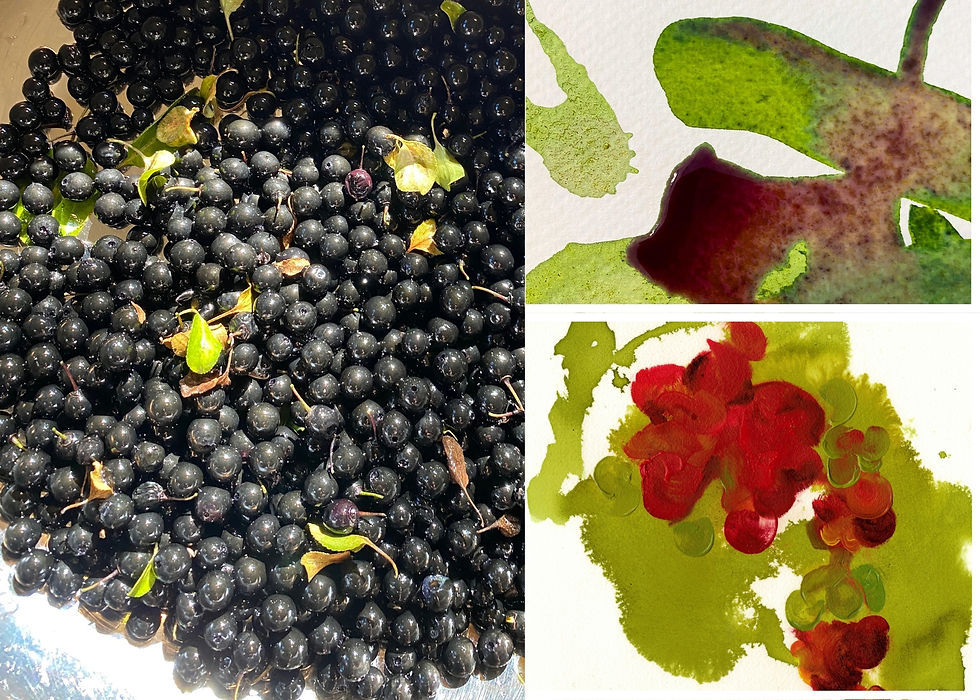The Natural Colors of "inter-"
- Mira

- 3 days ago
- 3 min read
Hand-foraged pigment, botanical color, and a study of what fades—and what endures.
In my new painting series inter-, every painting is a conversation between natural and archival materials. The first layer of each piece is made with color I’ve gathered, processed, and transformed by hand: roots, husks, berries, and fungi rendered into pigment. Over time, these colors will change. That’s part of the work. The second layer of each piece is made with archival oil paints that have been mixed to match, highlight, and amplify the natural colors beneath. While the natural materials will fade over time, the oil colors will hold the memory of what once was. That tension and interplay between forms and identities is at the hart of this body of work.
I wanted to introduce you to the natural materials that helped shape this series; they are not only materials and media--they are collaborators in the process. Each one carries its own story and its own rhythm of transforming over time.

Nebula Carrot
Made from locally grown black nebula carrots, this pigment began as a deep purple dye and was transformed through a process called laking—which binds plant color to a mineral and makes it usable as a solid pigment. When mixed into paint, it creates a vibrant cornflower blue that will fade gradually to a cool grey over time.
I love the way it moves both on canvas and paper—it doesn’t stay still. The color shifts, like the sky just before a storm.

Black Walnut
Sourced from walnut husks gathered here in Vermont, this ink is made simply by boiling and reducing the husks until a rich, caramel-brown liquid remains. It has a beautiful granularity when painted onto paper—almost like sediment settling in water.
Black walnut ink has been used in North America for centuries. It is one of the few natural inks that holds fast, and that sense of history and permanence is something I’ve leaned into in this series. The first layers of walnut ink were painted plein air (outdoors) in the early spring on the banks of the New Haven River in Vermont. The color and movement of the rushing spring water inspired the flowing and dripping forms in the inter- series.

Dyer’s Polypore Mushroom
This warm yellow pigment came from a mushroom gifted to me by mycologist and friend Meg Madden. Dyer’s polypore has long been used in natural dyeing, but this was my first time transforming a mushroom into a successful lake pigment (I’ve had many failed attempts and experiments over the years!). Like the carrot, it was processed through laking to preserve the color in powder form, then bound into paint with a tree sap binder.
The color is a warm, golden yellow—but its lightfastness is low to moderate. Over time, it may shift toward a chalky beige or grey. I don’t mind this. I see it as the pigment continuing to participate in the work, long after I’ve laid down the last wash of paint.

Buckthorn Berry
An invasive species here in Vermont, buckthorn can do real harm to local ecosystems. By harvesting these berries, I’m working with the landscape—removing a threat, and using its remnants to make something intentional and beautiful. These berries can be transformed into a vivid ink using a centuries-old recipe. Every time I lay down this color, it feels like I am performing a magic trick. In the bottle, the color looks deep purple-ish brown. However, once poured, painted, or dropped onto canvas or paper, the ink transforms within seconds to a vivid green. The color will continue to shift over time, transforming from dark green to chartreuse, gold, and eventually olive or brown tone.
Every painting in inter- begins with these foraged natural colors. They are layered with traditional oil paints—not blended, but balanced. Each color, each material, is in relationship with the next.
Thank you for making space for this kind of work. I can’t wait to share the full series with you.
— Mira
Artist, Growing In Process




Comments